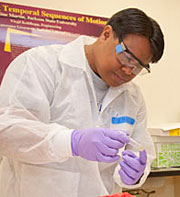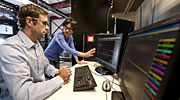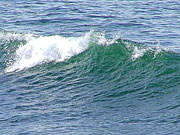- Number 371 |
- September 10, 2012
-
World's most powerful x-ray laser beam refined to scalpel precision
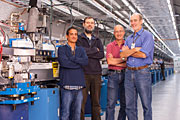 With a thin sliver of diamond, scientists at DOE’s SLAC National Accelerator Laboratory have transformed the world’s most powerful X-ray laser, the Linac Coherent Light Source, into an even more precise tool for exploring the nanoworld. The new technique focuses laser pulses to higher intensity in a much narrower band of X-ray wavelengths, and may enable experiments that were not possible before.
With a thin sliver of diamond, scientists at DOE’s SLAC National Accelerator Laboratory have transformed the world’s most powerful X-ray laser, the Linac Coherent Light Source, into an even more precise tool for exploring the nanoworld. The new technique focuses laser pulses to higher intensity in a much narrower band of X-ray wavelengths, and may enable experiments that were not possible before.
Laboratories around the world are already planning to incorporate this important advance into their own X-ray laser facilities. Like trading a hatchet for a scalpel, it will give researchers more control in studying and manipulating matter at the atomic level and will deliver sharper images of materials, molecules and chemical reactions. -
Scientist finds new way to predict heat layer troublemaker
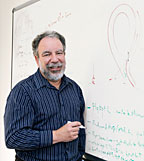 Researchers at a recent worldwide conference on fusion power have confirmed the surprising accuracy of a new model for predicting the size of a key barrier to fusion that a top scientist at DOE’s Princeton Plasma Physics Laboratory (PPPL) has developed. The model could serve as a starting point for overcoming the barrier. “This allows you to depict the size of the challenge so you can think through what needs to be done to overcome it,” said physicist Robert Goldston, the Princeton University professor of astrophysical sciences and former PPPL director who developed the model.
Researchers at a recent worldwide conference on fusion power have confirmed the surprising accuracy of a new model for predicting the size of a key barrier to fusion that a top scientist at DOE’s Princeton Plasma Physics Laboratory (PPPL) has developed. The model could serve as a starting point for overcoming the barrier. “This allows you to depict the size of the challenge so you can think through what needs to be done to overcome it,” said physicist Robert Goldston, the Princeton University professor of astrophysical sciences and former PPPL director who developed the model.
Goldston was among physicists who presented aspects of the model in late May to the 20th Annual International Conference on Plasma Surface Interactions in Aachen, Germany. Some 400 researchers from around the world attended the conference. Results of the model have been “eerily close” to the data, said Thomas Eich, a senior scientist at the Max Planck Institute for Plasma Physics in Garching, Germany, who gave an invited talk on his measurements. The agreement appears too close to have happened by chance, Eich added. -
Pollution weakens monsoon's might
Motorbike exhausts, coal-fired power plants and other emissions threaten the summer monsoons that are the primary water source for crops and daily living in South Asia, according to research by DOE’s Pacific Northwest National Laboratory. PNNL researchers used the Community Earth System Model with other components to study the effect of human-caused pollution particles on the South Asian summer monsoon. The team ran simulations of the climate in response to changes in particle emissions from pre-industrial to the present day. The team looked at the different responses to pollution's effects on the monsoon. The team found that local aerosols affect rainfall in the initial stages of the monsoon. Aerosols from Eastern Europe, the Middle East, and Africa are more important later in the summer.
The team’s results showed that overall monsoon rainfall was not very sensitive to changes in carbon-containing particles. While there are some atmospheric heating effects from soot particles, ultimately the surface cooling caused by the aerosols from fossil fuel use dominated during the monsoon season to slow down the atmospheric circulation and reduce monsoon rainfall. -
Seawater could be source of future uranium
Fueling nuclear reactors with uranium harvested from the ocean could become more feasible because of a material developed by a team led by DOE's Oak Ridge National Laboratory.
The combination of ORNL's high-capacity reusable adsorbents and a Florida company's high-surface-area polyethylene fibers creates a material that can rapidly, selectively and economically extract valuable and precious dissolved metals from water. The material HiCap, vastly outperforms today's best adsorbents, which perform surface retention of solid or gas molecules, atoms or ions. HiCap also effectively removes toxic metals from water, according to results verified by researchers at Pacific Northwest National Laboratory.
